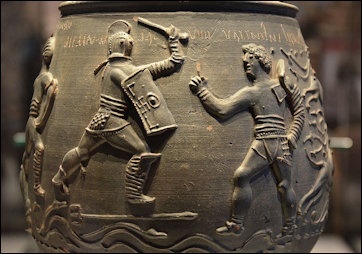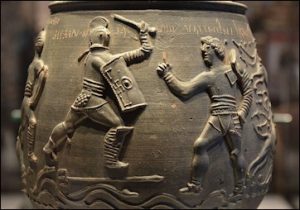In the annals of human history, the use of weapons has been an integral part of civilizations, shaping their rise and fall. From simple tools crafted for hunting and protection to sophisticated war machines designed for conquest, weaponry has played a significant role in shaping the course of ancient societies. This article delves into the fascinating world of weaponry in ancient civilizations, exploring the evolution, significance, and impact of these tools of war.
Table of Contents
- Introduction
- Early Innovations in Weaponry
- Stone Age Weapons: Tools of Survival
- Bronze Age Weapons: From Spears to Swords
- Weapons and Warfare in Ancient Egypt
- Bows and Arrows: Precision and Power
- Chariots: The Mobile Arsenal
- Martial Traditions of Ancient Greece
- Hoplites and Phalanxes: Unity in Defense
- Triremes: War on Water
- The Roman War Machine
- Gladii and Pila: Legionary Arms
- Siege Weapons: Breaking Fortifications
- Weapons of the Far East: China and Japan
- Chinese Crossbows: Projectiles of the Middle Kingdom
- Samurai Swords: The Soul of the Warrior
- Ancient Indian Warfare
- War Elephants: Behemoths of Battle
- Chakram: Circular Lethality
- Incas, Aztecs, and Mesoamerican Warfare
- Macuahuitl: The Obsidian Sword
- Atlatl: Spear-throwing Precision
- Weapons’ Influence on Civilization
- Technological Advancements and Innovation
- Cultural Impact and Symbolism
- Enduring Legacy of Ancient Weapons
- Conclusion
Introduction
Weapons have been instrumental in the survival, expansion, and shaping of ancient civilizations. They evolved from rudimentary tools into highly specialized instruments of war. These weapons were not only instruments of destruction but also cultural symbols, embodying the values and beliefs of their respective societies.
.png)
Early Innovations in Weaponry
Stone Age Weapons: Tools of Survival
During the Stone Age, humans crafted weapons primarily for hunting and self-defense. Sharpened stones, wooden clubs, and rudimentary spears were used to hunt game and protect against predators. These early tools laid the foundation for the future development of weaponry.
Bronze Age Weapons: From Spears to Swords
The advent of bronze metallurgy revolutionized weaponry. Bronze offered sturdier and sharper tools, leading to the creation of swords, daggers, and more advanced spears. This transition marked a pivotal moment in human history, as it enabled civilizations to better defend themselves and engage in conflicts.
Weapons and Warfare in Ancient Egypt
Bows and Arrows: Precision and Power
The ancient Egyptians perfected the use of bows and arrows, employing them for hunting and warfare. Their archers developed remarkable accuracy, and these skills were crucial in battles and defending their kingdom’s borders.

Chariots: The Mobile Arsenal
Chariots became a symbol of power and dominance in ancient Egypt. These horse-drawn vehicles, often carrying archers and spearmen, provided unmatched mobility on the battlefield, allowing swift maneuvers and tactical advantages.
Martial Traditions of Ancient Greece
Hoplites and Phalanxes: Unity in Defense
Ancient Greece’s iconic hoplites formed the core of their infantry. They wielded spears and shields and fought in tight formations called phalanxes. This unity and discipline were key factors in their military successes.
Triremes: War on Water
The maritime prowess of ancient Greece was demonstrated through triremes, agile warships powered by rowers. These vessels played a vital role in naval warfare, allowing city-states to project power across the Mediterranean.
The Roman War Machine
Gladii and Pila: Legionary Arms
The Roman legions relied on the gladius, a short sword, and the pilum, a throwing spear. These weapons, coupled with the legionaries’ formations, gave Rome a formidable edge in battle.
Siege Weapons: Breaking Fortifications
Rome’s engineering ingenuity extended to siege weapons like battering rams, ballistae, and siege towers. These machines were instrumental in breaching fortified enemy positions.
Weapons of the Far East: China and Japan
Chinese Crossbows: Projectiles of the Middle Kingdom
Chinese crossbows, with their advanced mechanisms, provided long-range capabilities and accuracy. They became integral in warfare and the defense of the Chinese realm.
Samurai Swords: The Soul of the Warrior
In Japan, the samurai’s katana held deep cultural and spiritual significance. These swords were not just weapons but extensions of a warrior’s honor and soul.
Ancient Indian Warfare
War Elephants: Behemoths of Battle
War elephants were living tanks on the ancient Indian battlefield. These colossal creatures struck fear into enemies and were pivotal in turning the tide of many conflicts.
Chakram: Circular Lethality
The chakram, a circular throwing weapon, showcased the ingenuity of ancient Indian weaponry. Its unique design allowed for both ranged attacks and close combat.
Incas, Aztecs, and Mesoamerican Warfare
Macuahuitl: The Obsidian Sword
The Aztecs employed the macuahuitl, a sword embedded with obsidian blades. This weapon combined cutting power with the sharpness of obsidian, making it deadly in battle.
Atlatl: Spear-throwing Precision
The atlatl, a spear-throwing device, gave Mesoamerican warriors extended range and accuracy in combat, allowing them to engage foes from a safer distance.
Weapons’ Influence on Civilization
Technological Advancements and Innovation
The development of weapons spurred technological innovations in metallurgy, engineering, and tactics. These advancements often had far-reaching effects beyond the battlefield, shaping the course of civilizations.
Cultural Impact and Symbolism
Weapons were not only tools of war but also symbols of cultural identity. They were depicted in art, myth, and literature, reflecting a civilization’s values, heroes, and fears.
Enduring Legacy of Ancient Weapons
The legacy of ancient weapons endures in modern times. Many designs and principles established by these civilizations still influence contemporary weapon development and military strategy.
Conclusion
The use of weapons in ancient civilizations was more than just a means of survival and conquest. It was a reflection of human innovation, cultural values, and the unending quest for power. These tools of war shaped the destinies of nations and left an indelible mark on the tapestry of history.
FAQs
- Did ancient civilizations use explosives as weapons? Explosives, as we know them today, were not present in ancient times. However, various civilizations did use incendiary devices and flammable materials for siege warfare.
- What role did religion play in ancient weaponry? Religion often intertwined with weaponry, as many civilizations believed their gods favored certain weapons or warriors. This belief added a spiritual dimension to the art of war.
- Were there female warriors in these civilizations? Yes, there were instances of female warriors in different ancient civilizations. They often played significant roles in defense and combat.
- How did the decline of an ancient civilization affect its weaponry? The decline of a civilization often led to the loss of advanced weaponry techniques. Invasions, conflicts, and the erosion of knowledge could result in a regression of weapon craftsmanship.
- Where can I learn more about ancient weapons? For more in-depth knowledge, you can explore museums, archaeological sites, and academic resources focused on ancient history and weaponry.







